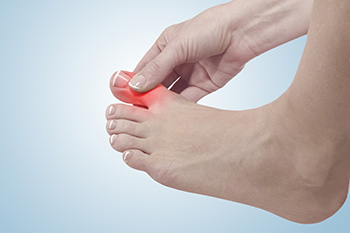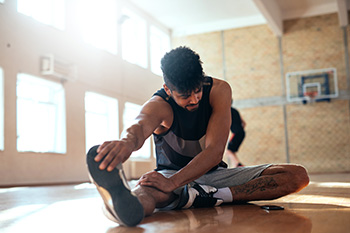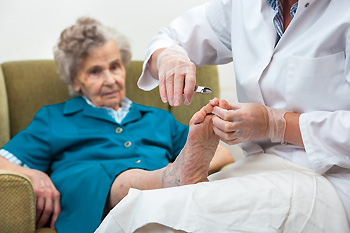Connect With Us
Blog
Items filtered by date: June 2024
Causes of Chronic Pain in the Big Toe

Pain in the big toe can arise from a variety of sources affecting its joints, muscles, tendons, and nerves. Chronic big toe pain ranges from dull aches to sharp, tingling sensations, similar to pins and needles. Other symptoms associated with big toe pain include numbness, burning sensations, difficulty moving the toe, and visible swelling. Among the common causes of big toe pain are arthritis, bunions, and calluses, all of which often worsen by natural wear and tear. Injuries like strains and sprains can also contribute to toe pain. In addition, inflammatory conditions, such as gout or bursitis, and structural problems, like hammer toe or nerve compression, can further complicate matters. Ignoring persistent toe pain can lead to serious complications including chronic discomfort, disability, and nerve damage. Seeking prompt medical attention from a podiatrist is important. This foot doctor can accurately diagnose the underlying cause of chronic big toe pain and suggest effective treatment strategies. If pain in the big toe worsens, it is suggested that you schedule an appointment with a podiatrist for an exam and treatment.
Toe pain can disrupt your daily activities. If you have any concerns, contact one of our doctors of Intercoastal Medical Group. Our doctors can provide the care you need to keep you pain-free and on your feet.
What Causes Toe Pain?
Most severe toe pain is caused due to a sports injury, trauma from dropping something heavy on the toe, or bumping into something rigid. Other problems can develop over time for various reasons.
Toe pain can be caused by one or more ailments. The most common include:
- Trauma
- Sports injury
- Wearing shoes that are too tight
- Arthritis
- Gout
- Corns and calluses
- Hammertoe
- Bunions
- Blisters
- Ingrown toenails
- Sprains
- Fractures (broken bones)
- Dislocations
When to See a Podiatrist
- Severe pain
- Persistent pain that lasts more than a week
- Signs of infection
- Continued swelling
- Pain that prevents walking
Diagnosis
In many cases the cause of toe pain is obvious, but in others, a podiatrist may want to use more advanced methods to determine the problem. These can range from simple visual inspections and sensation tests to X-rays and MRI scans. Prior medical history, family medical history, and any recent physical traumatic events will all be taken into consideration for a proper diagnosis.
Treatment
Treatments for toe pain and injuries vary and may include shoe inserts, padding, taping, medicines, injections, and in some cases, surgery. If you believe that you have broken a toe, please see a podiatrist as soon as possible.
If you have any questions please feel free to contact our offices located in Bradenton, and Sarasota, FL . We offer the newest diagnostic tools and technology to treat your foot and ankle needs.
We Can Treat Your Foot or Ankle Pain
Understanding and Preventing Bunions

A bunion is a bony bump that forms at the base of the big toe, resulting from misalignment of the joint. It can cause pain, swelling, and difficulty in finding comfortable footwear. Genetics, wearing tight or ill-fitting shoes, and certain foot shapes can contribute to bunion development. To prevent bunions, it is important to wear shoes with a wide toe box and avoid high heels that put pressure on the front of the foot. Custom orthotics can provide support and alleviate pressure on the big toe joint. Stretching and strengthening exercises for the feet can improve alignment and reduce strain. Early intervention, such as using bunion pads and maintaining a healthy weight, can also help prevent the progression of bunions. If you have a bunion, it is suggested that you speak to a podiatrist who can provide you with additional methods for relief and treatment options.
If you are suffering from bunions, contact one of our doctors of Intercoastal Medical Group. Our doctors can provide the care you need to keep you pain-free and on your feet.
What Is a Bunion?
A bunion is formed of swollen tissue or an enlargement of boney growth, usually located at the base joint of the toe that connects to the foot. The swelling occurs due to the bones in the big toe shifting inward, which impacts the other toes of the foot. This causes the area around the base of the big toe to become inflamed and painful.
Why Do Bunions Form?
Genetics – Susceptibility to bunions are often hereditary
Stress on the feet – Poorly fitted and uncomfortable footwear that places stress on feet, such as heels, can worsen existing bunions
How Are Bunions Diagnosed?
Doctors often perform two tests – blood tests and x-rays – when trying to diagnose bunions, especially in the early stages of development. Blood tests help determine if the foot pain is being caused by something else, such as arthritis, while x-rays provide a clear picture of your bone structure to your doctor.
How Are Bunions Treated?
- Refrain from wearing heels or similar shoes that cause discomfort
- Select wider shoes that can provide more comfort and reduce pain
- Anti-inflammatory and pain management drugs
- Orthotics or foot inserts
- Surgery
If you have any questions, please feel free to contact our offices located in Bradenton, and Sarasota, FL . We offer the newest diagnostic and treatment technologies for all your foot care needs.
How Stretching the Feet Keeps Them Healthy
 Keeping feet in top shape involves regular exercises and stretches that enhance flexibility, strength, and overall health, reducing the risk of injuries. Limbering up with a foot roll using a tennis ball helps massage and loosen the bottom of the foot. The bottom of the foot stretch, where you pull back on the toes while sitting, targets the plantar fascia, easing tension and preventing conditions like plantar fasciitis. The top-of-the-foot stretch is achieved by pointing the toes and gently pressing down, helping to alleviate tension and improve flexibility in the extensor muscles. Calf and Achilles stretches, such as leaning into a wall with one leg extended back, enhance the flexibility and strength of the calf muscles and Achilles tendon, essential for maintaining proper foot mechanics. The seated hamstring stretch, where you reach for your toes while seated, supports the overall flexibility of the leg, reducing strain on the feet. If you would like personalized advice on foot stretches and to address any foot concerns you may have, it is suggested that you consult a podiatrist.
Keeping feet in top shape involves regular exercises and stretches that enhance flexibility, strength, and overall health, reducing the risk of injuries. Limbering up with a foot roll using a tennis ball helps massage and loosen the bottom of the foot. The bottom of the foot stretch, where you pull back on the toes while sitting, targets the plantar fascia, easing tension and preventing conditions like plantar fasciitis. The top-of-the-foot stretch is achieved by pointing the toes and gently pressing down, helping to alleviate tension and improve flexibility in the extensor muscles. Calf and Achilles stretches, such as leaning into a wall with one leg extended back, enhance the flexibility and strength of the calf muscles and Achilles tendon, essential for maintaining proper foot mechanics. The seated hamstring stretch, where you reach for your toes while seated, supports the overall flexibility of the leg, reducing strain on the feet. If you would like personalized advice on foot stretches and to address any foot concerns you may have, it is suggested that you consult a podiatrist.
Stretching the feet is a great way to prevent injuries. If you have any concerns with your feet consult with one of our doctors from Intercoastal Medical Group. Our doctors will assess your condition and provide you with quality foot and ankle treatment.
Stretching the Feet
Stretching the muscles in the foot is an important part in any physical activity. Feet that are tight can lead to less flexibility and make you more prone to injury. One of the most common forms of foot pain, plantar fasciitis, can be stretched out to help ease the pain. Stretching can not only ease pain from plantar fasciitis but also prevent it as well. However, it is important to see a podiatrist first if stretching is right for you. Podiatrists can also recommend other ways to stretch your feet. Once you know whether stretching is right for you, here are some excellent stretches you can do.
- Using a foam roller or any cylindrical object (a water bottle or soda can will do), roll the object under your foot back and forth. You should also exert pressure on the object. Be sure to do this to both feet for a minute. Do this exercise three times each.
- Similar to the previous one, take a ball, such as a tennis ball, and roll it under your foot while seated and exert pressure on it.
- Grab a resistance band or towel and take a seat. If you are using a towel, fold it length wise. Next put either one between the ball of your foot and heel and pull with both hands on each side towards you. Hold this for 15 seconds and then switch feet. Do this three times for each foot.
- Finally hold your big toe while crossing one leg over the other. Pull the toe towards you and hold for 15 seconds. Once again do this three times per foot.
It is best to go easy when first stretching your foot and work your way up. If your foot starts hurting, stop exercising and ice and rest the foot. It is advised to then see a podiatrist for help.
If you have any questions, please feel free to contact our offices located in Bradenton, and Sarasota, FL . We offer the newest diagnostic and treatment technologies for all your foot care needs.
What Is Involved in Elderly Foot Care?
 Elderly foot care involves regular inspection, cleaning, and maintenance to ensure overall foot health. It is important because aging feet are more susceptible to incurring conditions like dry skin, brittle nails, and decreased circulation, which can lead to severe issues if not properly managed. As we age, feet undergo various changes such as thinning skin, loss of cushioning fat pads, and reduced blood flow. These changes can result in common problems like corns, calluses, bunions, and toenail disorders. Proper foot care includes daily washing, moisturizing to prevent dryness, trimming nails correctly, and wearing well-fitted, supportive shoes. Regular exercise and stretches can help maintain flexibility and strength. Monitoring for signs of infection, swelling, or other abnormalities is essential. Due to the increased risk of complications such as ulcers or infections especially in individuals with diabetes, it is suggested that if you are elderly, you visit a podiatrist regularly for professional care and advice.
Elderly foot care involves regular inspection, cleaning, and maintenance to ensure overall foot health. It is important because aging feet are more susceptible to incurring conditions like dry skin, brittle nails, and decreased circulation, which can lead to severe issues if not properly managed. As we age, feet undergo various changes such as thinning skin, loss of cushioning fat pads, and reduced blood flow. These changes can result in common problems like corns, calluses, bunions, and toenail disorders. Proper foot care includes daily washing, moisturizing to prevent dryness, trimming nails correctly, and wearing well-fitted, supportive shoes. Regular exercise and stretches can help maintain flexibility and strength. Monitoring for signs of infection, swelling, or other abnormalities is essential. Due to the increased risk of complications such as ulcers or infections especially in individuals with diabetes, it is suggested that if you are elderly, you visit a podiatrist regularly for professional care and advice.
Proper foot care is something many older adults forget to consider. If you have any concerns about your feet and ankles, contact one of our doctors from Intercoastal Medical Group. Our doctors can provide the care you need to keep you pain-free and on your feet.
The Elderly and Their Feet
As we age we start to notice many changes in our body, but the elder population may not notice them right away. Medical conditions may prevent the elderly to take notice of their foot health right away. Poor vision is a lead contributor to not taking action for the elderly.
Common Conditions
- Neuropathy – can reduce feeling in the feet and can hide many life-threatening medical conditions.
- Reduced flexibility – prevents the ability of proper toenail trimming, and foot cleaning. If left untreated, it may lead to further medical issues.
- Foot sores – amongst the older population can be serious before they are discovered. Some of the problematic conditions they may face are:
- Gouging toenails affecting nearby toe
- Shoes that don’t fit properly
- Pressure sores
- Loss of circulation in legs & feet
- Edema & swelling of feet and ankles
Susceptible Infections
Diabetes and poor circulation can cause general loss of sensitivity over the years, turning a simple cut into a serious issue.
If you have any questions please feel free to contact our offices located in Bradenton, and Sarasota, FL . We offer the newest diagnostic and treatment technologies for all your foot and ankle needs.

